Cockroach
Cockroaches are dark or black-bodied animals belonging to the Phylum Arthropoda's class Insecta. Cockroaches with bright yellow, red, and green colorshave also been documented in tropical areas. Their antennae, legs, and a flat extension of the upper body wall that conceals the head vary in size from 14 inches to 3 inches (0.6-7.6 cm). They are nocturnal omnivores who live in moist environments all over the world. They have become occupants of human homes, making them major pests and disease vectors.
(i)Morphology: The common cockroach, Periplaneta americana, has wings that extend past the tip of the abdomen in males and is around 34-53 mm long inadults. The cockroach's body is divided into three separate regions: the head, the thorax, and the abdomen. A strong chitinous exoskeleton covers the entire body (brown). Hardened plates called sclerites (tergites dorsally and sternites ventrally) are linked to each other by a thin and flexible articular membrane in each segment of the exoskeleton (arthrodial membrane).
The triangular head is positioned anteriorly at right angles to the longitudinal axis of the body. It is made up of the fusion of six segments and has a flexible neck that allows it to move freely in all directions. A pair of compound eyes can be found on the head capsule. Membranous receptacles in front of the eyes sprout a pair of thread-like antennae. Sensory receptors in antennae aid in environmental monitoring. Appendages on the anterior end of the skull produce biting and chewing mouth parts. A labrum (upper lip), a pair of mandibles, a pair of maxillae, and a labium make up the mouthparts (lower lip). The tongue (hypopharynx) is a flexible lobe that resides within the space encompassed by the mouthparts.
Prothorax, mesothorax, and metathorax are the three sections of the thorax. The neck is a short extension of the prothorax that connects the head to the thorax. Walking legs are attached to each thoracic section. The mesothorax produces the first pair of wings, whereas the metathorax produces the second pair. Tegmina, or opaque dark and leathery forewings (mesothoracic), cover the hind wings when at rest. The rear wings are transparent and membranous, and they help the animal fly.
Both males and females have ten segments in their abdomen. The 7th sternum is boat-shaped in females, and it creates a brood or genital pouch with the 8th and 9th sterna, which contains the female gonopore, spermathecal pores, and collateral glands in the front section.The genital pouch or chamber is located at the back end of the abdomen, between the 9th and 10th terga and the 9th sternum. Dorsal anus, ventral male genital hole, and gonapophysis are all found here. Males have a pair of short, threadlike anal styles that females lack. Anal cerci are a pair of jointed filamentous structures found on the 10th segment of both sexes.
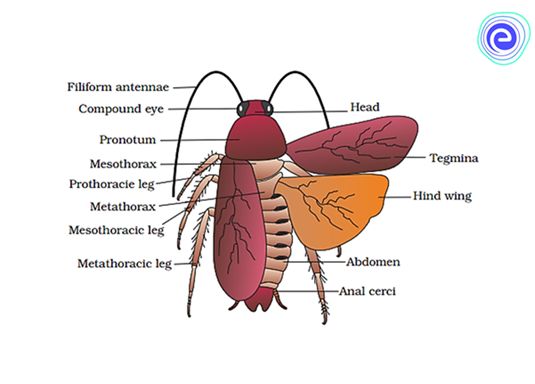
(ii) Anatomy: The alimentary canal is separated into three sections in the body cavity: foregut, midgut, and hindgut. The mouth opens into a short tubular pharynx, which leads to the oesophagus, a tiny tube conduit.
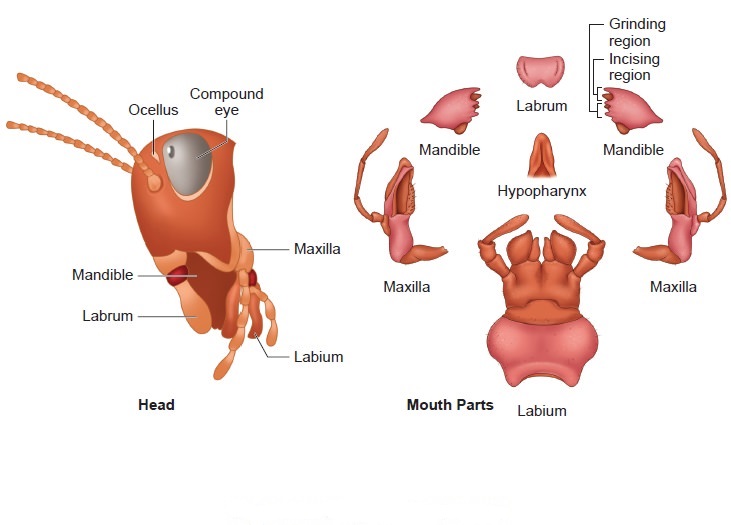
The esophagus expands into a sac-like structure called a crop, which is used to store food. Gizzard or proventriculus follows the crop. It possesses a thick outer layer of circular muscles and a thick inner cuticle that forms six teeth-like chitinous plates. The gizzard assists in the crushing of food particles. The cuticle covers the entire foregut. At the confluence of the foregut and midgut is a ring of 6-8 blind tubules called the hepatic or gastric caeca, which release digestive juice.Another ring of 100-150 yellow-colored thin filamentous Malpighian tubules exists at the midgut-hindgut junction. They aid in excretory product clearance from the hemolymph. The ileum, colon, and rectum make up the hindgut, which is larger than the midgut. Through the anus, the rectum opens up.
Cockroaches have an open blood circulatory system. The blood vessels are underdeveloped and open into the air (hemocoel). The blood bathes the visceral organs in the haemocoel (hemolymph). Colorless plasma and haemocytes make up the haemolymph. The cockroach's heart is an extended muscular tube that runs along the mid-dorsal line of the thorax and abdomen. It is divided into funnel-shaped chambers on both sides by ostia.Through the ostia, blood from the sinuses enters the heart and is pumped anteriorly to the sinuses. The respiratory system is made up of a network of trachea that open through ten pairs of small openings on the body's lateral side called spiracles. Air is carried to all parts by thin branching tubes (tracheal tubes separated into tracheoles). The sphincters control the opening of the spiracles.
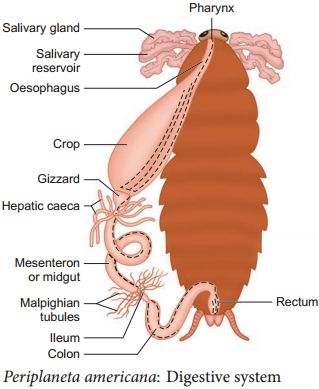
Diffusion occurs at the tracheoles to exchange gases. Malpighian tubules are responsible for excretion. Glandular and ciliated cells line each tubule. They take in nitrogenous waste and convert it to uric acid, which is then expelled through the hindgut. As a result, It is known as uricotelic.
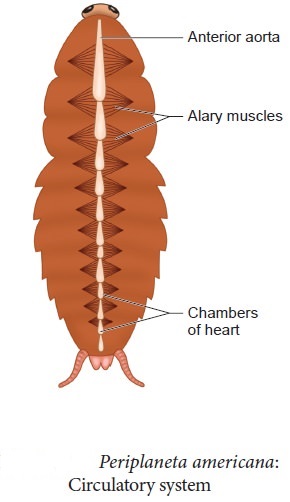
The fat body, nephrocytes, and urecose glands all contribute to excretion. On the ventral side, the cockroach's nervous system is made up of a series of fused, segmentally arranged ganglia connected by paired longitudinal connectives. The thorax has three ganglia and the abdomen has six. Cockroaches have a neurological system that runs throughout their bodies. A portion of the nervous system is located in the skull, while the rest is located on the ventral (belly) side of the animal. Because of this, even if a cockroach's head is removed, it can survive for up to one week. The brain is represented in the head area by the supra-oesophageal ganglion, which sends nerves to the antennae and compound eyes.
Antennae, eyes, maxillary palps, labial palps, anal cerci, and other sensory organs are found in cockroaches. The complex eyes are located on the head's dorsal surface. About 2000 hexagonal ommatidia make up each eye. A cockroach can obtain several photos of an object by using many ommatidia. Mosaic vision is a type of vision that has a higher sensitivity but lower resolution and is common at night (hence called nocturnal vision).
Cockroaches are dioecious, with well-developed reproductive organs in both sexes. A pair of testes, one on each lateral side in the 4th -6th abdominal segments, make up the male reproductive system.
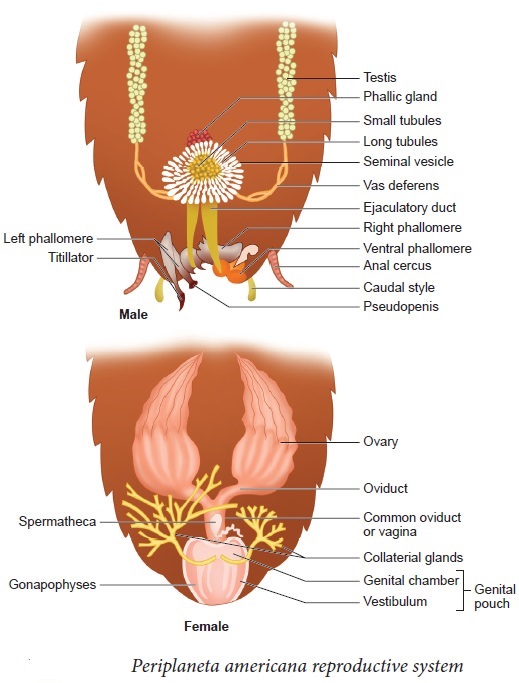
A narrow vas deferens develops from each testis and opens into the ejaculatory duct via the seminal vesicle.The male gonopore is located ventral to the anus and opens into the ejaculatory duct. In the 6th and 7th abdominal segments, there is a mushroom-shaped gland that serves as an accessory reproductive gland. Male gonapophysis or phallomeres depict the external genitalia (chitinous asymmetrical structures, surrounding the male gonopore). The sperm are retained in the seminal vesicles and cemented together in spermatophores, which are expelled during copulation. Two enormous ovaries lie laterally in the 2nd – 6th abdominal segments, forming the female reproductive system. Each ovary is made up of eight ovarian tubules, also known as ovarioles, which contain a chain of growing ova. Each ovary's oviducts join to form a single median oviduct (also known as the vagina), which exits into the genital chamber.The 6th segment, which enters the vaginal chamber, contains a pair of spermatheca. Spermatophores are used to transport sperm. The fertilized eggs are enclosed in oothecae capsules. The ootheca is a 3/8" (8 mm) length dark reddish to a blackish-brown capsule. They're dropped or bonded to a suitable surface, usually near a food source in a crack or crevice with high relative humidity. Females produce 9-10 oothecae on average, each holding 14-16 eggs. P. americana has a paurometabolous development, which means it develops through the nymphal stage. The nymphs have the appearance of adults. To attain adulthood, the nymph must molt 13 times.Wing pads are present in the next to last nymphal stage, however, only adult cockroaches have wings.
Many cockroach species are found in the wild and have yet to be identified as economically important. In and around the human habitat, a few species flourish. They are pests because their stinky excreta spoils food and contaminates it. By polluting food, they can spread a range of bacterial infections.

 ACME SMART PUBLICATION
ACME SMART PUBLICATION
